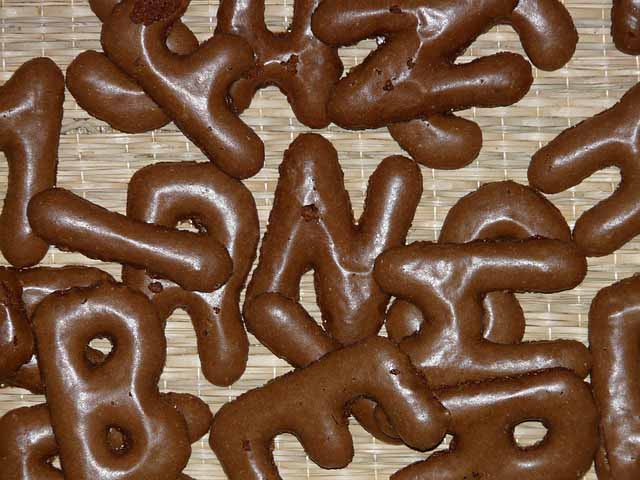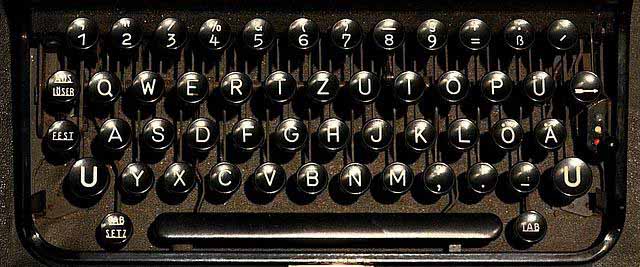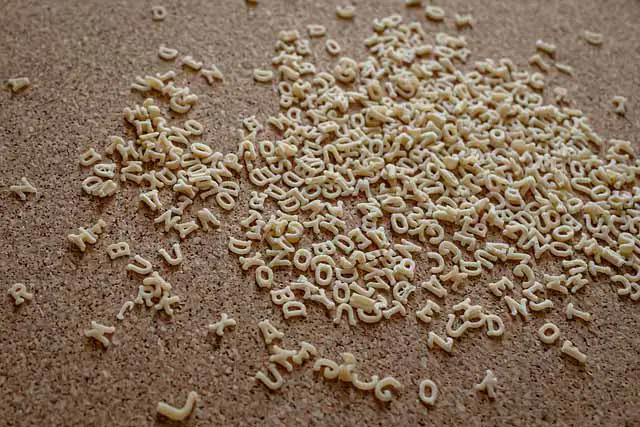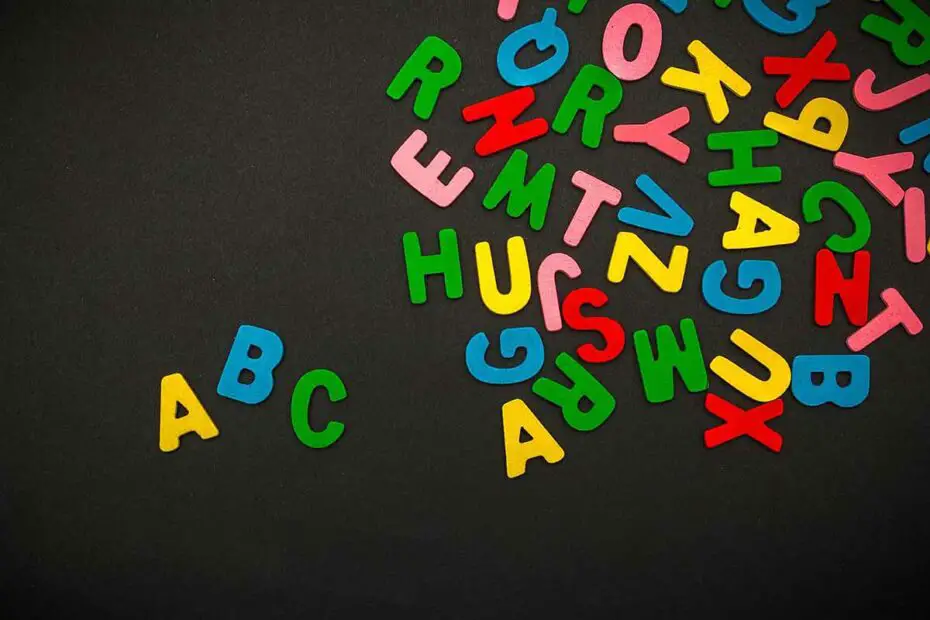When you want to learn German, you need to know the letters of the alphabet, of course. The German alphabet uses the same 26 letters you already know from the English alphabet. In fact, these letters are originally from the Latin language. But in German, there are four more letters. So, 30 letters all in all. Or possibly 29. Maybe 29.5? If you are confused now, don’t worry! When you want to know how many letters there are in the German alphabet, just keep on reading and you will learn all there is to know about German alphabet letters in no time.
The basic German Alphabet
The 26 letters in the German alphabet stemming from the Latin alphabet are the same you know from English and other languages based on Latin. And just as in English, you might also say the “German ABC” instead of alphabet. Although this phrase is more commonly used by children in elementary school. In fact, the term “ABC-Schützen” means children in primary school in German.
Each German letter can be written in lowercase or uppercase. Well, each letter apart from one. But we will get to that later. The first word of a sentence is always capitalized. And so are nouns as well as names.
The special German Letters: Umlauts and ß
As we said in the introduction, there are four letters in the German alphabet we don’t have in English. These are the umlauts and the letter ß.
The Umlaut in German
Umlauts are vowels with two dots above them. There are three umlauted vowels in the German language: ä, ö, ü.
They can be written as small letters like above or capitalized: Ä, Ö, Ü.
If you don’t have a German keyboard, you can substitute umlauts with the stem vowel followed by a small e: ae, oe, ue, Ae, Oe, Ue.
All native speakers know these letter combinations, so they will understand you perfectly.
Pronunciation of Umlauts
All three umlauts can be spoken as short or long vowels, depending on the word. We will try to give you some English equivalents of the German pronunciation here:
“ä” is pronounced like the “ai” in air.
German words with “ä” include ächtzen, Behälter, or Gehäuse, or Täler.
Some german words with “ö” are böse, mögen, or Föhn.
Native german words with “ü” are bücken, Müll, or über.

Image by Hans from Pixabay
What purpose do German Umlauts have?
Umlauts are often used to differentiate between singular and plural forms of nouns. In most cases, the stem vowel changes to an umlaut when the plural form of the noun ends in “e” or “er.” Here are some examples:
| Singular | Plural |
|---|---|
| Dach | Dächer |
| Frucht | Früchte |
| Hand | Hände |
| Haus | Häuser |
| Rock | Röcke |
| Ton | Töne |
| Tuch | Tücher |
| Zaun | Zäune |
But there also German words which contain umlauts in their stem form, like:
Böe, Färse, Büchse
In German verbs, umlauts (especially the ä) are also used to form other grammatical cases. This is a variant of the so called “Ablaut,” a change in the stem vowel in Germanic languages.
Ich blase – du bläst – er / sie / es bläst
Ich schlafe – du schläfst – er / sie / es schläft
Ich stoße – du stößt – er / sie / es stößt
Ich wasche – du wäschst – er / sie / es wäscht

Image by Elke from Pixabay
The ominous ß
As we already said above there are four special letters in the German alphabet. And this one’s really special, because it only exists in lowercase. This unusual letter is the ß (“sz” in German), also called the “sharp s” (or “scharfes s” in German).
If you don’t have a “ß” on your keyboard, you can substitute the sharp s with “ss” or with “sz.” In uppercase the “ß” is usually written as a double “S”, i.e. “SS.” (No connection to the infamous German “Schutzstaffel” (Protection Squad) during the Nazi era.)
For generations, German pupils had difficulties deciding whether to write “das” with a single s or ß. This was changed with the so-called German spelling reform (see below.) But that didn’t make life any easier for German pupils, because the old-fashioned “daß” was replaced with “dass.” So, there’s still a difference between “das” and “dass”, just the spelling has changed.
The way to remember whether to write “das” or “dass” is whether the word can be replaced with “dieses, jenes, welches” (this, that, which).
Example: “Das Haus, das er gekauft hatte, lag etwas abgelegen.” – “The house he had bought was a bit out of the way.” As you can see, you could say “the house, which he had bought” or “the house that he had bought.” So the “das” is written with one “s.”
“Er wusste sofort, dass er das Haus kaufen würde.” Now, while in English you could translate this sentence as “He knew immediately that he would buy the house,” the “that” doesn’t really fit into it in German. None of the following sentences:
- Er wusste sofort, dieses er das Haus kaufen würde.
- Er wusste sofort, jenes er das Haus kaufen würde.
- Er wusste sofort, welches er das Haus kaufen würde.
makes any sense in the German language. So it’s a case of a “dass.”
If you get this wrong occasionally, don’t fret. As I said above, German pupils have been struggling with this for generations and even grown-ups get it wrong from time to time.
German Spelling Boards
The following table shows all German letters, their pronunciation and how to spell them according to two German spelling boards. The DIN board is from the German institute of norms, which you might know from paper sizes, such as DIN A4. It uses German city names to spell the different German letters.
The postal spelling board from 1950 on the other hand uses mainly first names, with the odd exceptions of Kaufmann (merchant), Nordpol (northpole), and Quelle (well). In the case of the umlauts and the ß, I can understand it, as I’m not aware of any German first name starting with an umlaut or an ß. The same applies to the letter y.
But why they used “Kaufmann” instead of any German name like Klaus, Kurt, or Klara, I don’t know.
The two words “Siegfried” and “Zeppelin” are from an older version of the board from 1934 actually. But they are still being used more frequently than their newer siblings “Samuel” and “Zacharias”.
In my experience, most German speakers still use the older postal board instead of the newer DIN board.
| Small Letter | Capital Letter | Pronunciation | Postal Spelling | German Norm DIN 5009 |
|---|---|---|---|---|
| a | A | [a:] | Anton | Aachen |
| ä | Ä | [ɛ] | Ärger | Umlaut Aachen |
| b | B | [be:] | Berta | Berlin |
| c | C | [tse:] | Cäsar | Chemnitz |
| d | D | [de:] | Dora | Düsseldorf |
| e | E | [e:] | Emil | Essen |
| f | F | [εf] | Friedrich | Frankfurt |
| g | G | [ge:] | Gustav | Goslar |
| h | H | [ha:] | Heinrich | Hamburg |
| i | I | [i:] | Ida | Ingelheim |
| j | J | [jοt] | Julius | Jena |
| k | K | [ka:] | Kaufmann | Köln |
| l | L | [εl] | Ludwig | Leipzig |
| m | M | [εm] | Martha | München |
| n | N | [εn] | Nordpol | Nürnberg |
| o | O | [o:] | Otto | Offenbach |
| ö | Ö | [ø:] | Ökonom | Umlaut Offenbach |
| p | P | [pe:] | Paula | Potsdam |
| q | Q | [ku:] | Quelle | Quickborn |
| r | R | [εr:] | Richard | Rostock |
| s | S | [εs] | Siegfried | Salzwedel |
| ß | SZ | [s]] | Eszett | Eszett |
| t | T | [te:] | Theodor | Tübingen |
| u | U | [u:] | Ulrich | Unna |
| ü | Ü | [y:]] | Übermut | Umlaut Unna |
| v | V | [fau:] | Viktor | Völklingen |
| w | W | [ve:] | Wilhelm | Wuppertal |
| x | X | [iks] | Xanthippe | Xanten |
| y | Y | [ypsilεn] | Ypsilon | Ypsilon |
| z | Z | [tsεt] | Zeppelin | Zwickau |

shaped in the form of letters. — Image by Лариса Щербина from Pixabay
How did Spelling evolve in the German Language?
For centuries Germany was not a unified nation, but rather a mix of Counties, Principalities, and Duchies. The present territory of Germany was a patchwork of more than 300 small and medium-sized states, which were interconnected but did not form a unified state.
This also reflected in the German language. There were many regional dialects and the spelling of many words differed from region to region. There was no common German orthography. The first ones who tried to form some kind of universal German spelling were the poets of the early middle ages. They wanted their works to be understood by a larger audience and thus tried to come up with some kind of universal German. But their influence was limited as only the nobility in those days was able to read their poems.
A huge step forward towards a unified German language took place when the reformer Martin Luther translated the bible from Latin into German in 1522. Even though many people were illiterate, those who could read were able to read the bible in their own language for the first time. And it wasn’t only clergymen, but also teachers who then used the spelling from the German bible to teach their pupils how to write.
In the 19th century two brothers came up with the largest and most encompassing German dictionary ever written. This dictionary was a huge success and quickly sold 10,000 copies, and it became the definite standard of German spelling rules. You probably know these two brothers by another accomplishment, as it was the brothers Grimm who are more famous for their collection of German (and European) fairy tales and folk mythology, such as “Hansel and Gretel,” “Sleeping Beauty,” or “Little Red Riding Hood.”
In 1996 the so called German spelling reform tried to eliminate contradictions and inconsistencies in written German. Unfortunately many of the new rules themselves were inconsistent and the reform was met with much resistance by the general public. This led to two further reforms in 2004 and 2006, which partially reversed some of the new rules. But three reforms within 10 years also left many Germans confused about the correct spelling of some of the words.
So even today, you still have people writing words in their older forms, especially with “ß” whereby the modern form uses “ss” instead.




